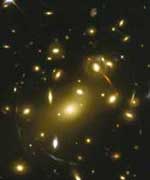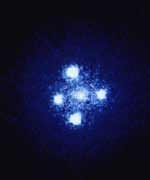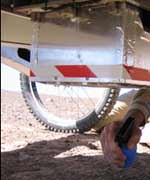
Image credit: Hubble
University scientists have co-founded an international collaboration that seeks to measure with new precision the mysterious force causing the universe to fly apart. Plans call for the project, named the Dark Energy Survey, to collect data on approximately 300 million galaxies spanning two-thirds of the history of the universe.
The survey could begin making observations as early as the fall of 2009. Although the DES remains more than four years away, more ambitious surveys will take at least a decade to produce results. ?I don?t want to wait that long,? said Joshua Frieman, Professor in Astronomy & Astrophysics and the College.
According to physics accounting methods, dark energy makes up 70 percent of the universe. Dark energy might be a manifestation of Albert Einstein?s cosmological constant, a force that acts at all times and in all places throughout the universe. It might also be a breakdown of Einstein?s theory of gravity on vast scales.
?It essentially requires gravity to be repulsive,? said Wayne Hu, Associate Professor in Astronomy & Astrophysics. ?That?s possible under our standard theories of gravity, but it?s not expected.? Whatever dark energy is, Frieman said, ?it?s likely to have profound implications for fundamental physics.?
The DES collaboration consists of researchers at Chicago, Fermi National Accelerator Laboratory, the University of Illinois at Urbana-Champaign, the Lawrence Berkeley National Laboratory and the Cerro Tololo Inter-American Observatory, as well as groups from the United Kingdom and Barcelona, Spain. Funding for the $20 million project is likely to come primarily from the U.S. Department of Energy, European funding agencies, the member institutions, and other agencies and sources.
Frieman heads the University?s component of the collaboration. Joining him and Hu in the collaboration are John Carlstrom, the S. Chandrasekhar Distinguished Service Professor in Astronomy & Astrophysics and the College; Scott Dodelson, Professor in Astronomy & Astrophysics and the Physical Sciences Collegiate Division; Stephen Kent, Associate Professor in Astronomy & Astrophysics; Erin Sheldon, Fellow in the Kavli Institute for Cosmological Physics; and Risa Wechsler, Hubble Fellow in the Kavli Institute for Cosmological Physics. Frieman and Dodelson also are members of Fermilab?s Theoretical Astrophysics Group, which Dodelson heads, while Kent heads Fermilab?s Experimental Astrophysics Group.
The DES will entail installing a 520-megapixel camera on the existing four-meter Blanco Telescope at the Cerro Tololo Inter-American Observatory in Chile. ?This would be larger than any existing optical camera in the world,? Frieman said.
A few hundred megapixels may not sound like much, Frieman said, ?but they?re not the same pixels that go into your hand-held. They have much higher sensitivity. They?re high-precision, high-efficiency detectors.? Furthermore, the camera will allow the scientists to survey the sky 10 times faster than they could at any existing U.S. observatory.
?The camera that?s now on the telescope just has too small a field of view. It would take us many decades to do the survey,? Frieman said.
The new camera will enable the DES to employ four techniques in attempting to discriminate between the two broad explanations for dark energy?the cosmological constant or a breakdown of gravity.
?The first method and the one that really drives the survey design is to count clusters of galaxies,? Frieman said. In this effort it will work in tandem with Carlstrom?s South Pole Telescope, which is scheduled to begin making observations in March 2007.
The SPT will help reveal if dark energy has suppressed the formation of galaxy clusters over the history of the universe. A radio telescope, the SPT will detect galaxy clusters by the way they distort the microwave radiation left over from the big bang. If theorists know how distant and how massive the galaxy clusters are, they can predict how many there should be in the presence of dark energy. The DES will make optical measurements to estimate their distance through the colors of the galaxies and their mass by gravitational lensing, the distortion of light by an intervening galaxy cluster. ?That?s a really elegant test,? Hu said.
The third technique employs gravitational lensing on a cosmic scale. Theorists can predict the effect of the dark energy on the large-scale distribution of the dark matter. With its large survey area, the DES can measure the tiny distortion of the images of galaxies induced by fluctuations in the dark matter density.
The fourth method involves the same technique that led to the 1998 discovery of dark energy: measuring the distance to a certain type of exploding star to reconstruct the expansion history of the universe. Astronomers studied these exploding stars expecting to find that the expansion of the universe had slowed as time went on. They discovered instead an accelerated expansion.
?These techniques complement each other very well,? Frieman said. ?They suffer from different sources of error, so if they agree, that gives you confidence in your result.?
For his part, Hu hopes the tests will reveal some discrepancy between predictions and reality. ?To me that would be the most exciting thing.?
Original Source: University of Chicago News Release


